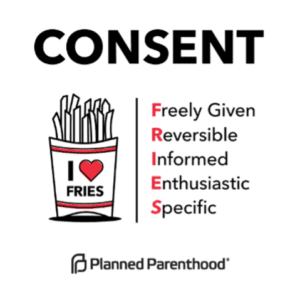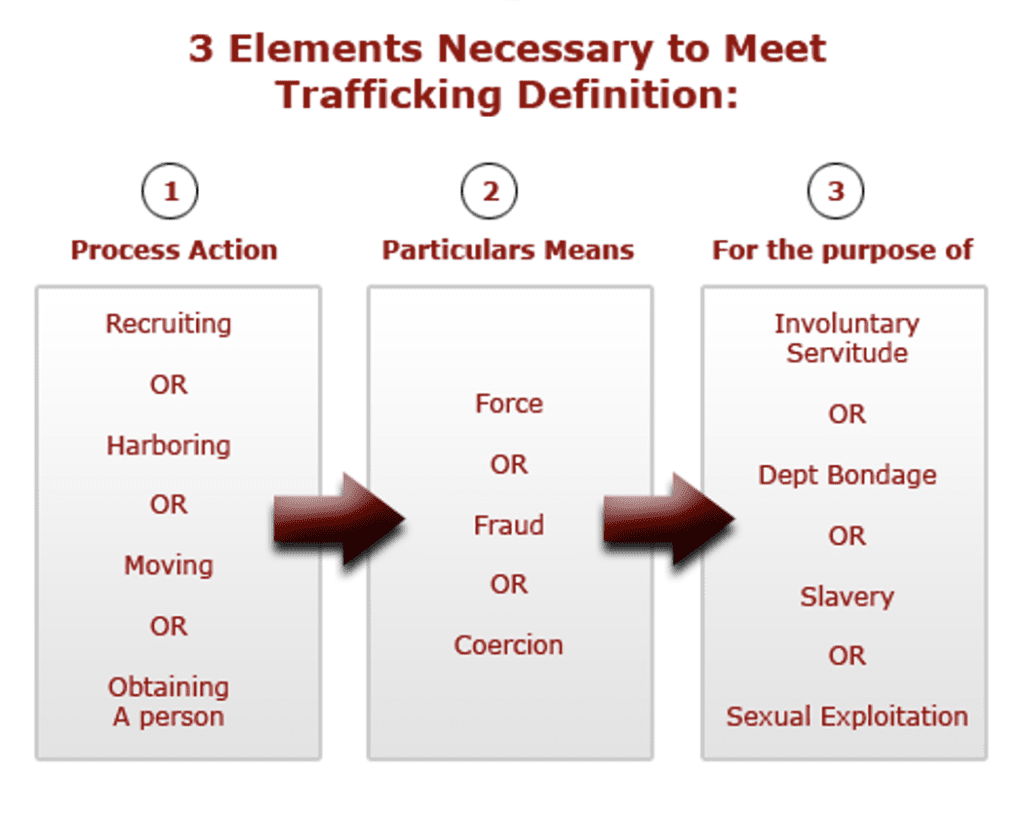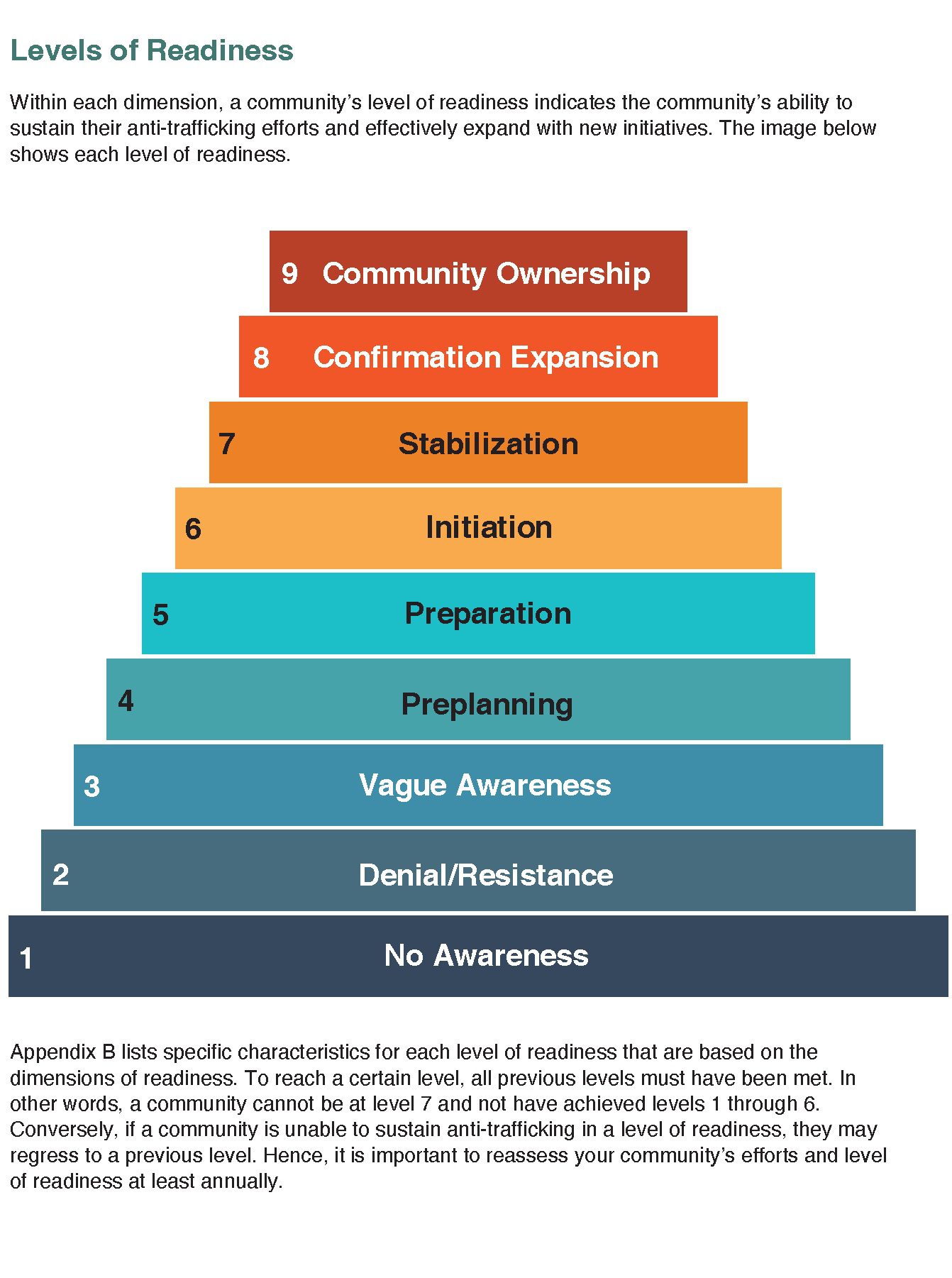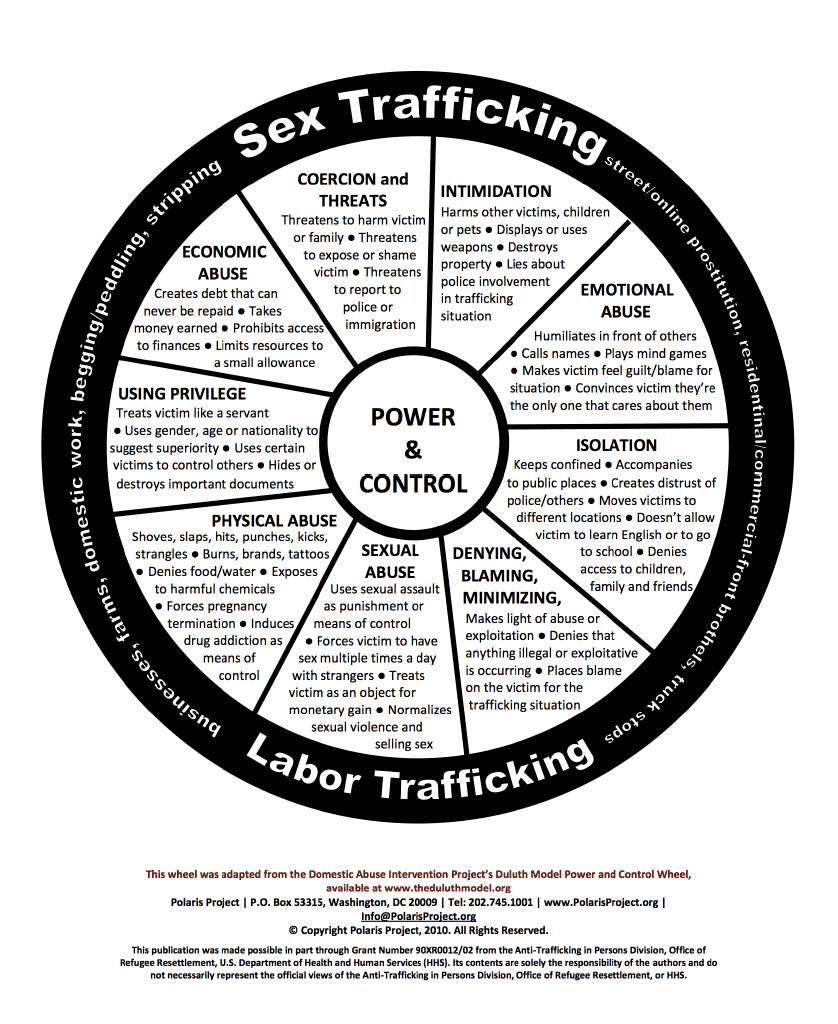Overview
Definitions, Dynamics and Laws of Trafficking & Child Sexual Abuse
The federal government defines CSAM/CSEM as any visual depiction, including any photograph, film, video, picture, or computer-generated image or picture, whether made or produced by electronic, mechanical, or other means, of sexually explicit conduct including the production involving the use of any person under the age of eighteen engaging in sexually explicit conduct. The visual picture has been created, adapted, or modified to display an identifiable child or adolescent engaging in sexually explicit conduct. The production of CSAM includes producing, directing, manufacturing, issuing, publishing, or advertising images or videos. If CSAM materials are dispersed and/or a profit is made, it may become a crime punishable under North Dakota and/or federal human trafficking laws.
CSEC is the exchange of any sex act and/or sexually explicit imagery for an agreed upon exchange. The exchange includes money or non-monetary goods, services, or agreements. Examples include money exchange apps or cash, shelter, a loving relationship, drugs/alcohol, or transportation. In North Dakota, CSEC is a crime punishable under human trafficking laws.
12.1-41-05, 12.1-41-06 North Dakota Century Code t12.1c41 (ndlegis.gov)
A crime that involves exploiting a person for labor, services, or commercial sex with the use of force, fraud, and/or coercion. Under U.S. federal law, “severe forms of trafficking in persons” includes both sex trafficking and labor trafficking.
the recruitment, harboring, transportation, provision, or obtaining of a person for labor or services, through the use of force, fraud, or coercion for the purposes of subjection to involuntary servitude, peonage, debt bondage, or slavery (22 USC § 7102)
MDTs are teams of multiple disciplines that work together to ensure wraparound services are provided for suspected or confirmed victims and survivors. Regional human trafficking navigators with the NDHTTF convene these teams regularly and as needed when cases are identified. Member agencies of these teams have a memorandum of understanding (MOU) with the task force, confirming their involvement and adhering to the guidelines of the MDT. MDTs are confirmed entities in various regions, reservations, and communities throughout North Dakota who have agreed to be involved in human trafficking cases on behalf of their agencies. MDTs can also be comprised of additional entities not regularly attending meetings; they can be an entity that victims and survivors are requesting be involved due to the services they provide. Other times, services available in the victim/survivor’s community are added to the team but do not regularly attend meetings or have a signed MOU.
MDTs and communities within North Dakota function at different levels of readiness when responding to human trafficking and their level of knowledge. Levels of readiness to respond appropriately are heavily based on education regarding human trafficking and exploitation, and the community’s understanding of human trafficking indicators and dynamics. Levels of readiness also depend upon whether MDTs are utilized and accessible in each community, and team members’ experience and expertise in the field, or lack thereof. A team or community’s level of readiness may change overtime due to these above circumstances, however engaging in ongoing readiness assessments of the team is crucial to ensuring a well-rounded response in each community. Click here for more in-depth information on MDTs.
Unfortunately, there is no reliable way to identify offenders and perpetrators as they come from various backgrounds throughout North Dakota. An offender is the individual who commits an illegal act against a human by threatening, coercing, or forcing them into sex or labor acts. In cases where offenders solicit sex from a child or adolescent, no threats, coercion, or force needs to be present for it to be considered a crime. Depending on where the illegal act was committed, the age of the victim(s) and dynamics of the abuse, offenders will be criminally charged for their actions against another human being.
12.1-41-02 North Dakota Century Code t12.1c41 (ndlegis.gov)
If someone is guilty of the crime of human trafficking, they had to have benefitted financially from the exchange of sex or labor, engaged in a commercial sex act with a child or adolescent, or have received anything of value determined by the involved parties. Please note that anything of value does not have to be monetary.
A human trafficking charge could also include assisting in the facilitation of the exchange of sex or labor services. For example, an offender could facilitate and organize the exchange of sex or intent to provide labor services between two individuals via social media and never actually meet or engage with either party.
the recruitment, harboring, transportation, provision, obtaining, patronizing, or soliciting of a person for the purposes of a commercial sex act, in which the commercial sex act is induced by force, fraud, or coercion, or in which the person induced to perform such an act has not attained 18 years of age (22 USC § 7102).
An individual knowingly and voluntarily disseminates indecent messages, photos, or videos of themselves engaging in sexually explicit behavior to another individual. Sexting is done via electronic means, and is often times referred to as “sending nudes”. Sometimes individuals, especially children and adolescents, disseminate these materials without force or coercion, which may later turn into blackmail or sextortion. Other times they are coerced or forced into sending these images and videos without feeling a sense of choice in the matter.
The National Center for Missing and Exploited Children (NCMEC) defines sextortion as a form of exploitation that occurs primarily online and in which non-physical forms of coercion are utilized, such as blackmail, to acquire sexual content (photos/videos) of the child or adolescent, obtain money from the child or adolescent, or engage in sex with the child or adolescent.
According to the Office for Victims of Crime, to be survivor-informed is to have a program, policy, intervention, or product that is designed, implemented, and evaluated with intentional leadership and input from victims and survivors to ensure that the program or product accurately represents the needs, interests, and perceptions of the target victim population. This is a priority area for the development of services and materials through the NDHTTF and is an encouraged approach for programming throughout the state.
A trafficker (more commonly known as a pimp in sex trafficking cases) is also a type of offender/perpetrator who facilitates and organizes the exchange of sex and/or labor for something of value. Traffickers recruit and groom, coerce and force, threaten, transport, harbor, maintain, or obtain victims for the sole purpose of gaining something of value. Traffickers often disguise themselves as a love interest, friend, rescuer, or parental figure to coerce victims into trusting them. Traffickers can also be family members, as familial trafficking is another common form known in North Dakota. In labor trafficking cases, traffickers pose themselves as a business owner or hard worker looking to hire staff and provide false information on victims’ work and living conditions. Sometimes these traffickers appear to need someone to work in their home and force/coerce victims into domestic servitude. They may also coordinate victims’ travel from other states or countries to ND to work.
Traffickers are typically violent, manipulative, and threatening where victims feel there is no safe or reliable escape. Most victims of human trafficking have a trafficker who organizes, facilitates, and/or forces victims into sex or labor acts, however due to fear and the unknown, victims often do not report any trafficker involvement. 12.1-41-02 North Dakota Century Code t12.1c41 (ndlegis.gov)
An adult or child/adolescent, male or female, who has been subjected to human trafficking or CSAM and who has been recruited, harbored, transported, provided, maintained, or obtained for labor, debt bondage, services, or a sexual act through the use of force, fraud, or coercion.
Survivors are individuals who have lived experience as a victim of human trafficking and/or CSAM, and identify themselves as someone who has survived and/or recovered from the life. Victims and survivors are to be asked what they prefer being labeled regarding their victimization. For purposes of this toolkit, they will be referred to as victims/survivors to ensure easily understandable terms for readers. However, those needing assistance may not want to be identified that way therefore it is crucial to ask victims/survivors before labeling them as such. For example, some survivors prefer being labeled a Thriver, where other survivors do not want to be associated with their trafficking experience whatsoever.
Sex trafficking stories can be found through multiple videos here:
https://thelifestory.org/
Wraparound services are the supportive options available to victims and survivors once they are identified. Wraparound services are developed through the MDT approach to ensure that a variety of services are available for victims and survivors in their community. The goal is to wrap around the victim providing care which includes basic needs, treatment services, medical needs, and supportive services unique to each individual.
Dynamics of Trafficking & Child Sexual Abuse
Social media and gaming systems have become an easily accessible and dangerous grooming, recruitment, exploitation, and blackmail risk to children and adolescents, and sometimes even adults. This method is much more common than kidnappings and abductions, or “stranger danger” which are rare occurrences in trafficking and CSAM cases in North Dakota.
Anytime online engagement, photo sharing, and communication occurs between two parties, it is a risk for grooming, recruitment, blackmail, and exploitation. Children and adolescents utilize the internet, gaming systems, and social media for communication and connection with others, often times sharing personal information such as their location, photos and videos, and identifying information. They may be sharing this information with an offender and/or trafficker. These perpetrators can easily download apps which make them appear to be younger, or create a fake profile altogether so victims may not know their true age or identity.
The information children and adolescents (and sometimes adults) share are often used against them; blackmailing (see Sextortion under the terminology section) or coercing to exploit or manipulate them, and often times children and adolescents are too uncomfortable or scared to report it. They may also be unaware that any danger is occurring. Children and adolescents may engage with individuals (whether known contacts or strangers they meet online) to form a friendship or romantic bond, not understanding the risk of sharing their information. This may lead to threats or coercion where they feel ‘stuck’ to adhere to what offenders are requesting of them, or may feel pressured to do so out of discomfort or a desire to be liked and accepted. It can also be a means for adults and/or children and adolescents to meet their basic needs; perhaps they need transportation or shelter and are offered assistance in exchange for online sexual engagement, they need to pay for their baby’s formula, or someone promises them love, affection, or someone to confide in in exchange for their personal information
This toolkit has a focus on ensuring that attitudes towards victims of human trafficking and CSAM are those of respect, empathy, and understanding. Victim-blaming culture has had a long-standing effect on victims of these horrific crimes, often adding shame and confusion to the trauma they endure. A lot of news articles, movies, tv shows, and social media depict victims of these crimes as having a choice and partaking in illegal activity. For example, there is little to no understanding of how victims were introduced to sex work therefore assuming it’s a choice and they can leave at any time, or assuming victims enjoy the work.
Jokes and mocking of these victims have been an ancient pattern in victim-blaming culture where victims are not shown empathy for their victimization. Victims and survivors are often questioned with, “why don’t you leave” instead of, “why can’t you leave?” which leaves them feeling responsible for the abuse they experienced. Society has a continuing reputation for siding with the offender, and often looks at victims as problems within our communities, as they have been labeled troubled kids, addicts, “prostitutes”, or illegal immigrants.
Language is a powerful and impactful tool. Language, labels, and terms can impact victims to feel either safe and empowered, or ashamed and angry. Language impacts whether or not victims feel comfortable accessing services or vocalizing their abuse. Some of the terminology and language regarding human trafficking adds to the overall victim-blaming culture and myths about this crime. Terms such as child prostitute or pimp, and language we use to be polite towards the offender. For example, articles that read, “sex with a child”, instead of using the word rape. Terms such as prostitute also depict choice which victims do not have any sense of. “Prostitute” also depicts criminal involvement which society often views as someone not worthy of help or services.
Other examples are how we describe exploitative situations, such as the statements, “a 15-year-old prostitute had sex with an adult man”. As children and adolescents cannot consent to sex and the adult is the offender, that statement should instead focus on placing responsibility on the adult and not labeling the victim. This statement should instead state, “adult male sexually exploits a child female.”
When referring to labor trafficking, oftentimes it is assumed those that are labor trafficked are not here legally or should be thankful for the opportunity to work here regardless of their unequal and abusive treatment.
Other harmful language would portray pity, such as the words saved or rescued when victims are assisted, supported, or recovered. These terms place more emphasis on the helper being a hero who “saved” a victim versus viewing the victim as resilient.
Using labels and terms with positive intention can be a powerful tactic in engaging with victims as well as for educational purposes, and to inspire culture change if used appropriately. It is the goal of this toolkit to continue to encourage community culture change around the use of negative labels and assumptions stemming from outdated and inaccurate societal norms.
Although it seems to be an easy concept, the idea of consent in sexual relations is not clear for children and adolescents and/or those in exploitative circumstances, and it is often used against them. Consent is to give permission, or to agree. It is important for those being exploited to understand that even when consent is given, individuals can change their mind in the moment or at any time.
Consent cannot be given for those under the age of 18 in the state of North Dakota as the age of consent for sex acts is 18. Consent cannot be given at any age when one or both parties are under the influence of drugs and/or alcohol.

Offenders are not easily identified. They can be dads and husbands, young adults, porn addicts, male or female, travelers from out of state, local farmers or working-class community members, the successful and wealthy, or homeless populations. Often times there is sympathy on behalf of offenders as the victims/survivors are to blame for ‘ruining the lives’ of those that offend.
Society has little understanding of the concept of choice for victims, assuming they choose this lifestyle, however the offenders are the true choice-makers. Offenders typically find those they want to purchase for sex by word of mouth or the internet, request and seek out services, pay for services and exploit the victim. Or, offenders exploit those through labor by coordinating their travel, offering them false promises, and choosing to overwork and underpay the victims involved.
The offenders are those that pay for services of an individual being exploited through sex or labor. Those that are buyers of sex often report addiction to porn or loneliness as reasons for exploitation and rape. Those that purchase humans for labor often state they needed helping hands but deny any allegations of exploitation or harm.
Trauma bonding happens overtime, where victims start to idealize their abusers to cope with the ongoing trauma they endure. Trauma bonds include a cycle of an unending emotional rollercoaster where victims feel safe and loved by their abuser, but then it quickly turns to abuse and an imbalance of power. Trauma bonds are toxic and dangerous, but are a strong emotional connection victims feel towards their abuser to seek out their love and approval.
Victims get addicted to the emotional rollercoaster of seeking their offender’s love and approval. They feel grateful for their abuser for providing them love and affection, a job, and other basic needs to survive even though it coincides with abuse and mistreatment. Sometimes, victims’ responses to danger are to freeze or fawn, meaning they do not leave and adhere to the abuser to avoid further harm. These are common responses for someone who is in immediate danger; it is their mind’s way of protecting themselves to provide a sense of “safety” and least harm, which is a part of the trauma bond dynamic.
The Power and Control wheel is a tool used in North Dakota for educational purposes, and to identify indicators that someone may be trafficked. This tool can be utilized while working alongside victims and survivors to help them understand their experiences. It can also be used to educate communities on what trafficking dynamics include and how to potentially identify them in various types of relationships.
Trafficking Laws
Click on resources below to find more information on North Dakota laws and codes and Federal Trafficking Laws.
Stages of Grooming
Traffickers are adept at identifying people with noticeable vulnerabilities or needs.
They’ll pose as good listeners, who care deeply, as they learn more about what they can do to insinuate themselves more deeply in the victim’s life
Offer solution to needs, fulfill those needs, and gain power.
Traffickers distance their victims from anyone who might weaken their influence or contradict the messaging they’re providing.

The process of exploiting their victims isn’t always transparent. They may start by pushing their victim to do things they might be uncomfortable with. Over time, the victim may be conditioned to believe that these requests are “normal.”
After traffickers establish control over their victims, they have to carefully craft strategies to maintain it. Continuing to isolate victims, threatening them or their loved ones if they attempt to leave, controlling them through their addiction, or even manipulating their sense of self.
Sometimes losing the idea, the illusion of love, is enough to keep a person in a trafficking situation.
Trafficker uses rewards and punishments within cycles of abuse to foster a powerful emotional connection with the victim.

Content sourced from Polaris Project: opens in a new windowHow Traffickers Groom & Control Their Victims



